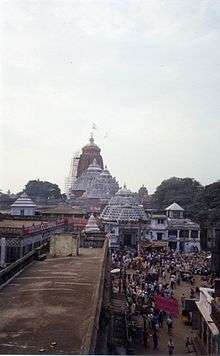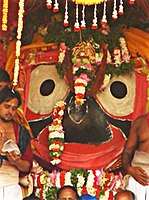Nilachal
The abode of Hindu deity Jagannath at Puri is known as the Nilachala or Niladri, [Nila (Blue) + Achala (Mountain)] meaning, The Blue Mountain.
The Nilachala is a place of high religious significance in Hinduism and is one of the four Char Dhams. Religious teachers like Shri Ramanuja Acharya, Swami Vishnuswami visited Nilachala in the Twelfth century and established a mathas. Shri Nimbarka Acharya also visited Puri, as also Guru Nanak Dev and many other Acharyas. Shri Chaitanya spent 18 years at Nilachal dhama.
As per religious texts and the Skanda Purana, mythical King Indradyumna of Avanti once dreamt of the great deity Nila Madhava (Blue Madhava) being worshipped at the Nilachal mount. The King sent out many priests and messengers in the search of the elusive deity Nila Madhava. Finally, Vidyapati, one of the priests of King Indradyumna located Nilachala as well as Nila Madhava at the Purusottam Kshetra (The land of the Supreme Being) and took the news back to the King. However, as per divine designs, the Nila Madhava deity vanished before Indradyumna could undertake darshan. But, subsequently, propitiated, the God appeared as Jagannath at Nilachal.
Geographically, though, there is no such apparent geographic structure at Puri, the township being located at the coastal plains of Eastern Odisha. Such a reference to a seemingly non-existent mountain has been a matter of debate which throws light on the origin of the deity.
Hypotheses regarding existence of the Blue Mountain
Hypothesis 1
Indologist and Jagannath cult researcher, Heinrich von Stietencron in "The Advent of Vishnuism in Orissa: An Outline of its History According to Archaeological and Epigraphical Sources from the Gupta Period up to 1135 AD." in A. Eschmann et al., The Cult of Jagannath and the Regional Tradition of Orissa, Delhi: Manohar, pp. 1–30, hypothesizes the actual existence of a mountain at Puri in the past and notes the following:
'No real mountain exists in the Puri town. Yet it is true that the Jagannath temple was actually built on a hill which receded sharply on its western side. Drifting sands and the sediments of continuous settlement have combined to raise the ground at the foot of the hill considerably so that the difference in level to the temple is no longer striking. It can be noticed, however, when approaching the ancient Siva temples which were situated to the west and to the north of the Hill.'[1]
Yet contrary to such opinion, the platform of the Jagannath temple, seems to be a totally man-made monument, not a modified natural hill. The Nilachala consists almost entirely of a platform, and at its north—western foot lies an artificial cave. This is approximately 25 feet below the level of the inner enclosure, for a staircase of about twenty two steps leads down to the sanctum of deity Patalesvara Shiva, and gives some idea of the level of the original terrain. The site was obviously exposed to flooding during the monsoon season as once the river touched its lowest steps when it flowed in the broad road just in front of the temp
Hypothesis 2
Another hypothesis regarding the naming of Puri as 'Nilachala' has been advanced by the noted historian, Dr. Krushna Chandra Panigrahi, in his "History of Orissa", pp. 338–339. It has been argued that no mountain existed at the Jagannath shrine, and:
""Then the Bhaumas came from Assam in the first part of the eighth century A.D., ruled over Orissa, obtained the shrine from the Savaras, got the temple built on the spot and gave it the name Nilachala, which was the name of the famous shrine of Kamakhya in their homeland of Assam."."
In the 19th century, certain scholars have imagined that the Nilachala (Blue Hill) concealed the debris of a former Buddhist monument named Dantapura. However, Puri cannot be identified with Dantapura and so far no Buddhist remains have been discovered there.
See also
- "Nilachaley Mahaprabhu"- Biopic of Chaitanya Mahaprabhu
References
- Stietencron, pp. 1-30.
- Das, Bikram: Domain Of Jagannath - A Historical Study, BR Publishing Corporation.
- Das, Suryanarayan: Jagannath Through the Ages, Sanbun Publishers, New Delhi. (2010)
- Eschmann, A., H. Kulke and G.C. Tripathi (Ed.): The Cult of Jagannath and the Regional Tradition of Orissa, 1978, Manohar, Delhi.
- Hunter, W.W. Orissa: The Vicissitudes of an Indian Province under Native and British Rule, Vol. I, Chapter-III, 1872.
- Kulke, Hermann in The Anthropology of Values, Berger Peter (ed.): Yayati Kesari revisited, Dorling Kindrsley Pvt. Ltd., (2010).
- Mahapatra, K.N.: Antiquity of Jagannath Puri as a place of pilgrimage, OHRJ, Vol.III, No.1, April, 1954, p. 17.
- Mishra, K.C.: The Cult of Jagannath, Calcutta, 1971.
- Mishra, Narayan and Durga Nandan: Annals and antiquities of the temple of Jagannath, Sarup & Sons, New Delhi, 2005.
- Panigrahi, K. C.: History of Orissa, Kitab Mahal, Cuttack, 2nd ed. (1981)
- Patnaik, H.S.: Jagannath, His Temple, Cult and Festivals, Aryan Books International, New Delhi, 1994, ISBN 81-7305-051-1.
- Patnaik, N.: Sacred Geography of Puri : Structure and Organisation and Cultural Role of a Pilgrim Centre, Year: 2006, ISBN 81-7835-477-2
- Starza-Majewski, Olgierd M. L: The Jagannatha temple at Puri and its Deities, Amsterdam, 1983.
- Starza-Majewski, Olgierd Maria Ludwik: The Jagannatha Temple At Puri: Its Architecture, Art And Cult, E.J. Brill (Leiden and New York). [1993]
- Stietencron, Heinrich von: "The Advent of Vishnuism in Orissa: An Outline of its History According to Archaeological and Epigraphical Sources from the Gupta Period up to 1135 AD." in Eschmann, A. et al., The Cult of Jagannath and the Regional Tradition of Orissa, Delhi: Manohar, pp. 1–30
External links
| Wikimedia Commons has media related to Jagannath. |


